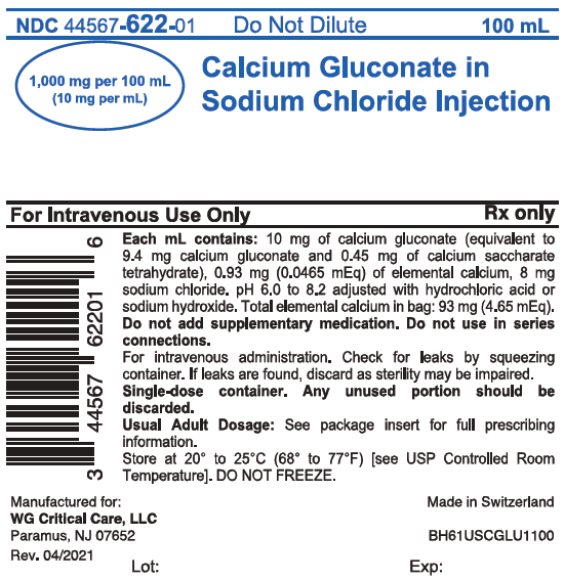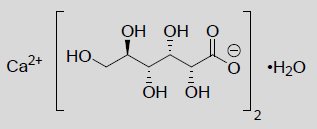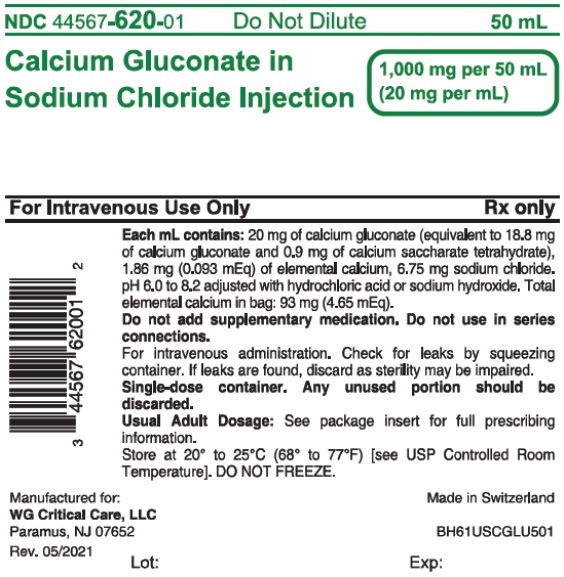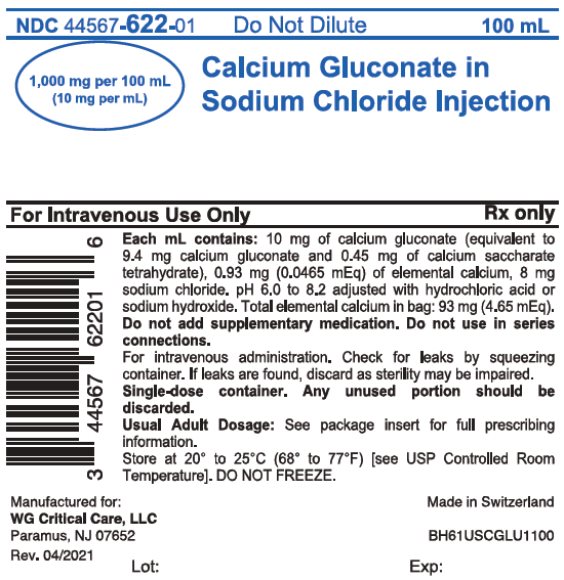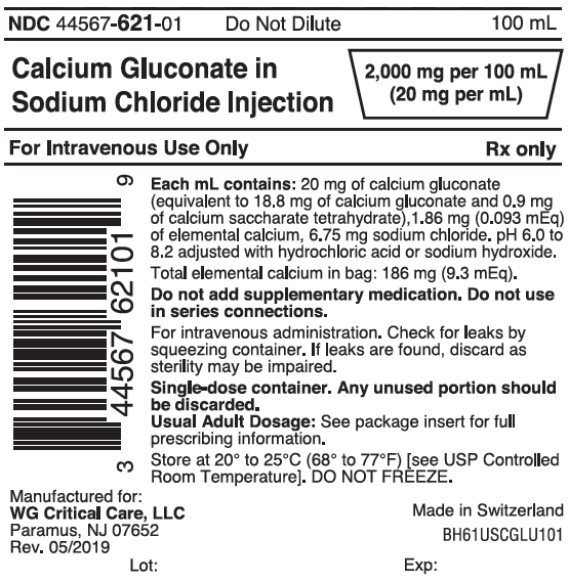Label: CALCIUM GLUCONATE IN SODIUM CHLORIDE- calcium gluconate injection, solution
-
NDC Code(s):
44567-620-01,
44567-620-24,
44567-621-01,
44567-621-24, view more44567-622-01, 44567-622-24
- Packager: WG Critical Care, LLC
- Category: HUMAN PRESCRIPTION DRUG LABEL
- DEA Schedule: None
- Marketing Status: New Drug Application
Drug Label Information
Updated September 18, 2023
If you are a consumer or patient please visit this version.
- Download DRUG LABEL INFO: PDF XML
- Official Label (Printer Friendly)
-
HIGHLIGHTS OF PRESCRIBING INFORMATION
These highlights do not include all the information needed to use CALCIUM GLUCONATE IN SODIUM CHLORIDE INJECTION safely and effectively. See full prescribing information for CALCIUM GLUCONATE IN SODIUM CHLORIDE INJECTION.
CALCIUM GLUCONATE IN SODIUM CHLORIDE injection, for intravenous use
Initial U.S. Approval: 1941
INDICATIONS AND USAGE
DOSAGE AND ADMINISTRATION
• Administer intravenously (bolus or continuous infusion) via a secure intravenous line (2.1) (2)
• See Full Prescribing Information (FPI) for administration rates, and appropriate monitoring (2.1) (2)
• Do not dilute Calcium Gluconate in Sodium Chloride Injection prior to use. Any unused portion should be discarded (2.1) (2)
• Individualize the dose within the recommended range in adults and pediatric patients depending on the severity of symptoms of hypocalcemia, the serum calcium level, and the acuity of onset of hypocalcemia. See Table 1 in the FPI for dosing recommendations in mg of calcium gluconate for neonates, pediatric and adult patients. (2.2) (2)
• Measure serum calcium during intermittent infusions every 4 to 6 hours and during continuous infusion every 1 to 4 hours. (2.3) (2)
• Calcium Gluconate Injection is not physically compatible with fluids containing phosphate or bicarbonate. Precipitation may result if mixed. See FPI for all drug incompatibilities. (2.5) (2)
DOSAGE FORMS AND STRENGTHS
CONTRAINDICATIONS
WARNINGS AND PRECAUTIONS
• Arrhythmias with Concomitant Cardiac Glycoside Use: If concomitant therapy is necessary, Calcium Gluconate in Sodium Chloride Injection should be given slowly in small amounts and close ECG monitoring is recommended (5.1) (5)
• End-Organ Damage due to Intravascular Ceftriaxone-Calcium Precipitates: Concurrent use of intravenous ceftriaxone may cause life-threatening precipitates. Do not administer ceftriaxone simultaneously with Calcium Gluconate in Sodium Chloride Injection via a Y-site in any age group. Cases of fatal outcomes in neonates have occurred. (4, 5.2) (5)
• Tissue Necrosis and Calcinosis: Calcinosis cutis can occur with or without extravasation of Calcium Gluconate in Sodium Chloride Injection. Tissue necrosis, ulceration, and secondary infection are the most serious complications. If extravasation occurs or clinical manifestations of calcinosis cutis are noted, immediately discontinue intravenous administration at that site and treat as needed. (5.3) (5)
• Hypotension, Bradycardia, and Cardiac Arrhythmias with Rapid Administration: To avoid adverse reactions that may follow rapid intravenous administration, Calcium Gluconate in Sodium Chloride Injection should be infused slowly, with careful ECG monitoring for cardiac arrhythmias. (5.4) (5)
• Aluminum Toxicity: This product contains aluminum, up to 25 mcg per liter, that may be toxic. (5.5) (5)
ADVERSE REACTIONS
The most common adverse events with Calcium Gluconate Injection are local soft tissue inflammation and necrosis, calcinosis cutis and calcification that are related to extravasation. Other adverse events include vasodilation, decreased blood pressure, bradycardia, cardiac arrhythmia, syncope, and cardiac arrest. (6)
To report SUSPECTED ADVERSE REACTIONS, contact WG Critical Care, LLC at 1-866-562-4708 or FDA at 1-800-FDA-1088 or www.fda.gov/medwatch.
DRUG INTERACTIONS
• Cardiac Glycoside: Synergistic arrhythmias may occur if calcium and cardiac glycosides are administered together. (7.1) (7)
• Calcium Channel Blockers: Administration of calcium may reduce the response. (7.2) (7)
• Drugs that may cause hypercalcemia: Vitamin D, vitamin A, thiazide diuretics, estrogen, calcipotriene and teriparatide administration may cause hypercalcemia. Monitor plasma calcium concentrations in patients taking these drugs concurrently. (7.3) (7)
USE IN SPECIFIC POPULATIONS
See 17 for PATIENT COUNSELING INFORMATION.
Revised: 9/2023
-
Table of Contents
FULL PRESCRIBING INFORMATION: CONTENTS*
1 INDICATIONS AND USAGE
2 DOSAGE AND ADMINISTRATION
2.1 Important Administration Instructions
2.2 Recommended Dosage
2.3 Serum Calcium Monitoring
2.4 Dosage in Renal Impairment
2.5 Drug Incompatibilities
3 DOSAGE FORMS AND STRENGTHS
4 CONTRAINDICATIONS
5 WARNINGS AND PRECAUTIONS
5.1 Arrhythmias with Concomitant Cardiac Glycoside Use
5.2 End-Organ Damage due to Intravascular Ceftriaxone-Calcium Precipitates
5.3 Tissue Necrosis and Calcinosis
5.4 Hypotension, Bradycardia, and Cardiac Arrhythmias with Rapid Administration
5.5 Aluminum Toxicity
6 ADVERSE REACTIONS
7 DRUG INTERACTIONS
7.1 Cardiac Glycosides
7.2 Calcium Channel Blockers
7.3 Drugs that may cause Hypercalcemia
8 USE IN SPECIFIC POPULATIONS
8.1 Pregnancy
8.2 Lactation
8.4 Pediatric Use
8.5 Geriatric Use
8.6 Renal Impairment
8.7 Hepatic Impairment
10 OVERDOSAGE
11 DESCRIPTION
12 CLINICAL PHARMACOLOGY
12.1 Mechanism of Action
12.3 Pharmacokinetics
13 NONCLINICAL TOXICOLOGY
13.1 Carcinogenesis, Mutagenesis, Impairment of Fertility
16 HOW SUPPLIED/STORAGE AND HANDLING
17 PATIENT COUNSELING INFORMATION
- *
- Sections or subsections omitted from the full prescribing information are not listed.
- 1 INDICATIONS AND USAGE
-
2 DOSAGE AND ADMINISTRATION
2.1 Important Administration Instructions
- See Table 1 for amounts of elemental calcium in Calcium Gluconate in Sodium Chloride Injection.
Table 1. Amounts of Calcium Gluconate and Elemental Calcium
Total Strength per Total Volume
Strength per mL
Elemental Calcium (mg) per mL
Elemental Calcium (mEq) per mL
Total Amount of Elemental Calcium (mg) per Total Volume
Total Amount of Elemental Calcium (mEq) per Total Volume
1,000 mg per 50 mL
20 mg/mL
1.86 mg
0.093 mEq
93 mg per 50 mL
4.65 mEq per 50 mL
1,000 mg per 100 mL
10 mg/mL
0.93 mg
0.0465 mEq
93 mg per 100 mL
4.65 mEq per 100 mL
2,000 mg per 100 mL
20 mg/mL
1.86 mg
0.093 mEq
186 mg per 100 mL
9.3 mEq per 100 mL
- •
- Do not dilute Calcium Gluconate in Sodium Chloride Injection prior to use. Any unused portion should be discarded.
- •
- Inspect Calcium Gluconate in Sodium Chloride Injection visually prior to administration. The solution should appear clear and colorless. Do not administer if there is particulate matter or discoloration.
- •
- Administer Calcium Gluconate in Sodium Chloride Injection intravenously via a secure intravenous line to avoid calcinosis cutis and tissue necrosis [see Warnings and Precautions (5.3)].
Administer Calcium Gluconate in Sodium Chloride Injection by continuous infusion at the rate recommended in Table 1 [see Dosage and Administration (2.2)] and monitor patients, vitals, calcium and ECG during the infusion [see Warnings and Precautions (5.4)].
2.2 Recommended Dosage
Individualize the dose of Calcium Gluconate in Sodium Chloride Injection within the recommended range depending on the severity of symptoms of hypocalcemia, the serum calcium level, and the acuity of onset of hypocalcemia.
Table 2 provides dosing recommendations for Calcium Gluconate in Sodium Chloride Injection in mg of calcium gluconate for neonates, pediatric and adult patients.
Table 2. Dosing Recommendations in mg of Calcium Gluconate for Neonate, Pediatric, and Adult Patients
PatientPopulation
Initial Dose
Subsequent Doses (if needed)
Bolus
Continuous Infusion
Neonate (less than1 month to 1 month)
100 mg/kg to 200 mg/kg
100 mg/kg to 200 mg/kg every 6 hours
Initiate at 17 mg/kg/hour to 33 mg/kg/hour
Pediatric (greater than 1 month to less than 17 years)
29 mg/kg to 60 mg/kg
29 mg/kg to 60 mg/kg every 6 hours
Initiate at 8 mg/kg/hour to 13 mg/kg/hour
Adult (17 years and greater)
1,000 mg to 2,000 mg
1,000 mg to 2,000 mg every 6 hours
Initiate at 5.4 mg/kg/hour to 21.5 mg/kg/hour
For bolus administration, DO NOT exceed an infusion rate of:
- •200 mg/minute in adult patients
- •100 mg/minute in pediatric patients
For continuous infusions, adjust rate as needed based on serum calcium levels
2.3 Serum Calcium Monitoring
Measure serum calcium every 4 to 6 hours during intermittent infusions with Calcium Gluconate in Sodium Chloride Injection and measure serum calcium every 1 to 4 hours during continuous infusion.
2.4 Dosage in Renal Impairment
For patients with renal impairment, initiate Calcium Gluconate in Sodium Chloride Injection at the lowest dose of the recommended dose ranges for all age groups and monitor serum calcium levels every 4 hours.
2.5 Drug Incompatibilities
• Do not mix Calcium Gluconate in Sodium Chloride Injection with ceftriaxone. Concurrent use of intravenous ceftriaxone and Calcium Gluconate in Sodium Chloride Injection can lead to the formation of ceftriaxone-calcium precipitates. Concomitant use of ceftriaxone and intravenous calcium-containing products is contraindicated in neonates (28 days of age or younger) [see Contraindications (4)]. In patients older than 28 days of age, ceftriaxone and calcium-containing products may be administered sequentially, provided the infusion lines are thoroughly flushed between infusions with a compatible fluid. Ceftriaxone must not be administered simultaneously with intravenous calcium-containing solutions via a Y-site in any age group [see Warnings and Precautions (5.2), Drug Interactions (7.3)].
• Do not mix Calcium Gluconate in Sodium Chloride Injection with fluids containing bicarbonate or phosphate. Calcium Gluconate Injection is not physically compatible with fluids containing phosphate or bicarbonate. Precipitation may result if mixed.
• Do not mix Calcium Gluconate in Sodium Chloride Injection with minocycline injection. Calcium complexes minocycline rendering it inactive.
-
3 DOSAGE FORMS AND STRENGTHS
Calcium Gluconate in Sodium Chloride Injection is a clear, colorless solution available as:
Injection:
• Calcium gluconate 1,000 mg per 50 mL (20 mg/mL) single-dose bag
• Calcium gluconate 1,000 mg per 100 mL (10 mg/mL) single-dose bag
• Calcium gluconate 2,000 mg per 100 mL (20 mg/mL) single-dose bag
- 4 CONTRAINDICATIONS
-
5 WARNINGS AND PRECAUTIONS
5.1 Arrhythmias with Concomitant Cardiac Glycoside Use
Cardiac arrhythmias may occur if calcium and cardiac glycosides are administered together. Hypercalcemia increases the risk of digoxin toxicity. Administration of Calcium Gluconate in Sodium Chloride Injection should be avoided in patients receiving cardiac glycosides. If concomitant therapy is necessary, Calcium Gluconate in Sodium Chloride Injection should be given slowly in small amounts and with close ECG monitoring [see Drug Interactions (7.1)].
5.2 End-Organ Damage due to Intravascular Ceftriaxone-Calcium Precipitates
Concomitant use of ceftriaxone and Calcium Gluconate in Sodium Chloride Injection is contraindicated in neonates (28 days of age or younger) due to cases of fatal outcomes in neonates in which a crystalline material was observed in the lungs and kidneys at autopsy after ceftriaxone and calcium were administrated simultaneously through the same intravenous line. Concomitant administration can lead to the formation of ceftriaxone-calcium precipitates that may act as emboli, resulting in vascular spasm or infarction [see Contraindications (4)].
In patients older than 28 days of age, ceftriaxone and Calcium Gluconate in Sodium Chloride Injection may be administered sequentially, provided the infusion lines are thoroughly flushed between infusions with a compatible fluid. Do not administer Ceftriaxone simultaneously with Calcium Gluconate in Sodium Chloride Injection via a Y-site in any age group.
5.3 Tissue Necrosis and Calcinosis
Intravenous administration of Calcium Gluconate in Sodium Chloride Injection and local trauma may result in calcinosis cutis due to transient increase in local calcium concentration. Calcinosis cutis can occur with or without extravasation of Calcium Gluconate in Sodium Chloride Injection, is characterized by abnormal dermal deposits of calcium salts, and clinically manifests as papules, plaques, or nodules that may be associated with erythema, swelling, or induration. Tissue necrosis, ulceration, and secondary infection are the most serious complications.
If extravasation occurs or clinical manifestations of calcinosis cutis are noted, immediately discontinue intravenous administration at that site and treat as needed.
5.4 Hypotension, Bradycardia, and Cardiac Arrhythmias with Rapid Administration
Rapid injection of Calcium Gluconate in Sodium Chloride Injection may cause vasodilation, decreased blood pressure, bradycardia, cardiac arrhythmias, syncope and cardiac arrest. To avoid adverse reactions that may follow rapid intravenous administration, Calcium Gluconate in Sodium Chloride Injection should be infused slowly. If rapid intravenous bolus of Calcium Gluconate Injection is required, the rate of intravenous administration should not exceed 200 mg/minute in adults and 100 mg/minute in pediatric patients and ECG monitoring during administration is recommended [see Dosage and Administration (2.1)].
5.5 Aluminum Toxicity
Calcium Gluconate in Sodium Chloride Injection contains aluminum, up to 25 mcg per liter, that may be toxic. Aluminum may reach toxic levels with prolonged parenteral administration if kidney function is impaired. Premature neonates are particularly at risk because their kidneys are immature, and they require large amounts of calcium and phosphate solutions, which contain aluminum. Research indicates that patients with impaired kidney function, including premature neonates, who receive parenteral levels of aluminum at greater than 4 mcg/kg/day to 5 mcg/kg/day accumulate aluminum levels associated with central nervous system and bone toxicity. Tissue loading may occur at even lower rates of administration.
-
6 ADVERSE REACTIONS
The following serious adverse reactions are also described elsewhere in the labeling:
• Arrhythmias with Concomitant Cardiac Glycoside Use [see Warnings and Precautions (5.1)]
• End-Organ Damage due to Intravascular Ceftriaxone-Calcium Precipitates [see Warnings and Precautions (5.2)]
• Tissue Necrosis and Calcinosis [see Warnings and Precautions (5.3)]
• Hypotension, Bradycardia, and Cardiac Arrhythmias [see Warnings and Precautions (5.4)]
• Aluminum toxicity [see Warnings and Precautions (5.5)]
The following adverse reactions associated with the use of calcium gluconate were identified in the literature. Because these reactions are reported voluntarily from a population of uncertain size, it is not always possible to estimate their frequency reliably or to establish a causal relationship to drug exposure.
Cardiovascular: Vasodilation, decreased blood pressure, bradycardia, cardiac arrhythmia, syncope, cardiac arrest
Administration site reactions: Local soft tissue inflammation, local necrosis, calcinosis cutis and calcification due to extravasation
-
7 DRUG INTERACTIONS
7.1 Cardiac Glycosides
Hypercalcemia increases the risk of digoxin toxicity, while digoxin may be therapeutically ineffective in the presence of hypocalcemia. Synergistic arrhythmias may occur if calcium and cardiac glycosides are administered together. Avoid administration of Calcium Gluconate in Sodium Chloride Injection in patients receiving cardiac glycosides; if considered necessary, administer Calcium Gluconate in Sodium Chloride Injection slowly in small amounts and monitor ECG closely during administration.
-
8 USE IN SPECIFIC POPULATIONS
8.1 Pregnancy
Risk summary
Limited available data with Calcium Gluconate Injection use in pregnant women are insufficient to inform a drug associated risk of adverse developmental outcomes. There are risks to the mother and the fetus associated with hypocalcemia in pregnancy [see Clinical Considerations].
The estimated background risk of major birth defects and miscarriage for the indicated population is unknown. In the U.S. general population, the estimated background risk of major birth defects and miscarriage in clinically recognized pregnancies is 2-4% and 15-20%, respectively.
Clinical Considerations
Disease-associated maternal risk
Maternal hypocalcemia can result in an increased rate of spontaneous abortion, premature and dysfunctional labor, and possibly preeclampsia.
Fetal/Neonatal adverse reactions
Infants born to mothers with hypocalcemia can have associated fetal and neonatal hyperparathyroidism, which in turn can cause fetal and neonatal skeletal demineralization, subperiosteal bone resorption, osteitis fibrosa cystica and neonatal seizures. Infants born to mothers with hypocalcemia should be carefully monitored for signs of hypocalcemia or hypercalcemia, including neuromuscular irritability, apnea, cyanosis and cardiac rhythm disorders.
8.2 Lactation
Risk summary
Calcium is present in human milk as a natural component of human milk. It is not known whether intravenous administration of Calcium Gluconate in Sodium Chloride Injection can alter calcium concentration in human milk. There are no data on the effects of Calcium Gluconate Injection on the breastfed infant, or on milk production. The developmental and health benefits of breastfeeding should be considered along with the mother’s clinical need for Calcium Gluconate in Sodium Chloride Injection and any potential adverse effects on the breastfed child from Calcium Gluconate in Sodium Chloride Injection or from the underlying maternal condition.
8.4 Pediatric Use
The safety and effectiveness of Calcium Gluconate in Sodium Chloride Injection have been established in pediatric patients for the treatment of acute, symptomatic hypocalcemia.
Pediatric approval for Calcium Gluconate in Sodium Chloride Injection, including doses, is not based on adequate and well-controlled clinical studies. Safety and dosing recommendations in pediatric patients are based on published literature and clinical experience [see Dosage and Administration (2.2)].
Concomitant use of ceftriaxone and Calcium Gluconate in Sodium Chloride Injection is contraindicated in neonates (28 days of age or younger) due to reports of fatal outcomes associated with the presence of lung and kidney ceftriaxone-calcium precipitates. In patients older than 28 days of age, ceftriaxone and Calcium Gluconate Injection may be administered sequentially, provided the infusion lines are thoroughly flushed between infusions with a compatible fluid [see Contraindications (4) and Warnings and Precautions (5.2)]. This product contains up to 25 mcg/L aluminum which may be toxic, particularly for premature neonates due to immature renal function. Parenteral administration of aluminum greater than 4 mcg/kg/day to 5 mcg/kg/day is associated with central nervous system and bone toxicity [see Warnings and Precautions (5.5)].
8.5 Geriatric Use
In general dose selection for an elderly patient should start at the lowest dose of the recommended dose range, reflecting the greater frequency of decreased hepatic, renal, or cardiac function, and of concomitant disease or other drug therapy.
-
10 OVERDOSAGE
Overdosage of Calcium Gluconate in Sodium Chloride Injection may result in hypercalcemia. Symptoms of hypercalcemia typically develop when the total serum calcium concentration is ≥12 mg/dL. Neurologic symptoms include depression, weakness, fatigue, and confusion at lower levels, with patients experiencing hallucinations, disorientation, hypotonicity, seizures, and coma. Effects on the kidney include diminished ability to concentrate urine and diuresis.
If overdose of Calcium Gluconate in Sodium Chloride Injection occurs immediately discontinue administration and provide supportive treatments to restore intravascular volume as well as promote calcium excretion in the urine if necessary.
-
11 DESCRIPTION
Calcium Gluconate in Sodium Chloride Injection is a sterile, preservative-free, nonpyrogenic solution of calcium gluconate, a form of calcium, for intravenous use.
Calcium Gluconate is calcium D-gluconate (1:2) monohydrate. The structural formula is:
Molecular formula: C12H22CaO14• H2O
Molecular weight: 448.39
Solubility in water: 3.5 g/100 mL at 25°C
Calcium Gluconate in Sodium Chloride Injection is available as 1,000 mg per 50 mL (equivalent to 18.8 mg per mL calcium gluconate anhydrous) 1,000 mg per 100 mL (equivalent to 9.4 mg per mL calcium gluconate anhydrous) or 2,000 mg per 100 mL (equivalent to 18.8 mg per mL calcium gluconate anhydrous) in single-dose bags.
Table 3. Calcium Gluconate Formulations
1,000 mg per 50 mL
1,000 mg per 100 mL
2,000 mg per 100 mL
Calcium Gluconate
20 mg per mL
10 mg per mL
20 mg per mL
Elemental Calcium
1.86 mg per mL
0.93 mg per mL
1.86 mg per mL
Sodium Chloride
6.75 mg per mL
8 mg per mL
6.75 mg per mL
Hydrochloric Acid or Sodium Hydroxide
pH adjusted 6.0 to 8.2
-
12 CLINICAL PHARMACOLOGY
12.1 Mechanism of Action
Intravenous administration of calcium gluconate increases serum ionized calcium level. Calcium gluconate dissociates into ionized calcium in plasma. Ionized calcium and gluconate are constituents of body fluids.
12.3 Pharmacokinetics
Absorption
Calcium Gluconate Injection is 100% bioavailable following intravenous injection.
Metabolism
Calcium itself does not undergo direct metabolism. The release of ionized calcium from intravenous administration of calcium gluconate is direct and does not seem to be affected by the first pass through the liver.
Distribution
Calcium in the body is distributed mainly in skeleton (99%). Only 1% of the total body calcium is distributed within the extracellular fluids and soft tissues. About 50% of total serum calcium is in the ionized form and represents the biologically active part. 8% to 10% serum calcium is bound to organic and inorganic acid and approximately 40% is protein-bound (primarily to albumin).
Elimination
Studies have shown a relationship between urinary calcium excretion and the intravenous administration of calcium gluconate, with a significant increase in urinary calcium excretion observed after the intravenous administration of calcium gluconate.
-
13 NONCLINICAL TOXICOLOGY
13.1 Carcinogenesis, Mutagenesis, Impairment of Fertility
Long-term studies in animals have not been conducted to evaluate the carcinogenic potential of Calcium Gluconate in Sodium Chloride Injection. Calcium gluconate was not mutagenic with or without metabolic activation in the Ames test with Salmonella typhimurium (strains TA-1535, TA-1537, and TA-1538) or Saccharomyces cerevisiae (Strain D4). Fertility studies in animals have not been conducted with calcium gluconate administered by the intravenous route.
-
16 HOW SUPPLIED/STORAGE AND HANDLING
Calcium Gluconate in Sodium Chloride Injection is a clear, colorless solution supplied in single-dose bags with an aluminum overwrap available as:
Total Strength per Total Volume
Strength per mL
24 single-dose bags NDC
Bag and Overwrap NDC
1,000 mg per 50 mL
20 mg/mL
44567-620-24*
44567-620-01
1,000 mg per 100 mL
10 mg/mL
44567-622-24
44567-622-01
2,000 mg per 100 mL
20 mg/mL
44567-621-24
44567-621-01
*partial fill container 50 mL volume in a 100 mL container.
Store at 20° to 25°C (68° to 77°F) [see USP Controlled Room Temperature]. Do not freeze. Product should be used within 60 days of removal from aluminum overwrap.
Preservative-free. Discard any unused portion in the single-dose bag immediately.
-
17 PATIENT COUNSELING INFORMATION
Inform patients of the risks associated with infusion of Calcium Gluconate in Sodium Chloride Injection including local tissue inflammation, local necrosis and calcinosis. [see Warnings and Precautions (5.3)].
Manufactured for:
WG Critical Care, LLC
Paramus, NJ 07652
Made in Switzerland
U.S. Patent Numbers 10,342,813 and 10,130,646
- PACKAGE/LABEL PRINCIPAL DISPLAY PANEL
- Package/Label Display Panel
- PACKAGE/LABEL PRINCIPAL DISPLAY PANEL
-
INGREDIENTS AND APPEARANCE
CALCIUM GLUCONATE IN SODIUM CHLORIDE
calcium gluconate injection, solutionProduct Information Product Type HUMAN PRESCRIPTION DRUG Item Code (Source) NDC:44567-620 Route of Administration INTRAVENOUS Active Ingredient/Active Moiety Ingredient Name Basis of Strength Strength CALCIUM GLUCONATE MONOHYDRATE (UNII: CZN0MI5R31) (CALCIUM CATION - UNII:2M83C4R6ZB) CALCIUM GLUCONATE MONOHYDRATE 20 mg in 1 mL Inactive Ingredients Ingredient Name Strength CALCIUM SACCHARATE (UNII: 6AP9J91K4V) HYDROCHLORIC ACID (UNII: QTT17582CB) SODIUM HYDROXIDE (UNII: 55X04QC32I) SODIUM CHLORIDE (UNII: 451W47IQ8X) Other Ingredients Ingredient Kind Ingredient Name Quantity Does not contain NATURAL LATEX RUBBER (UNII: 2LQ0UUW8IN) 0 in 1 mL Packaging # Item Code Package Description Marketing Start Date Marketing End Date 1 NDC:44567-620-24 24 in 1 CARTON 10/26/2018 1 NDC:44567-620-01 1 in 1 POUCH 1 50 mL in 1 BAG; Type 0: Not a Combination Product Marketing Information Marketing Category Application Number or Monograph Citation Marketing Start Date Marketing End Date NDA NDA210906 10/26/2018 CALCIUM GLUCONATE IN SODIUM CHLORIDE
calcium gluconate injection, solutionProduct Information Product Type HUMAN PRESCRIPTION DRUG Item Code (Source) NDC:44567-622 Route of Administration INTRAVENOUS Active Ingredient/Active Moiety Ingredient Name Basis of Strength Strength CALCIUM GLUCONATE MONOHYDRATE (UNII: CZN0MI5R31) (CALCIUM CATION - UNII:2M83C4R6ZB) CALCIUM GLUCONATE MONOHYDRATE 10 mg in 1 mL Inactive Ingredients Ingredient Name Strength CALCIUM SACCHARATE (UNII: 6AP9J91K4V) HYDROCHLORIC ACID (UNII: QTT17582CB) SODIUM HYDROXIDE (UNII: 55X04QC32I) SODIUM CHLORIDE (UNII: 451W47IQ8X) Other Ingredients Ingredient Kind Ingredient Name Quantity Does not contain NATURAL LATEX RUBBER (UNII: 2LQ0UUW8IN) 0 in 1 mL Packaging # Item Code Package Description Marketing Start Date Marketing End Date 1 NDC:44567-622-24 24 in 1 CARTON 07/13/2021 1 NDC:44567-622-01 1 in 1 POUCH 1 100 mL in 1 BAG; Type 0: Not a Combination Product Marketing Information Marketing Category Application Number or Monograph Citation Marketing Start Date Marketing End Date NDA NDA210906 07/13/2021 CALCIUM GLUCONATE IN SODIUM CHLORIDE
calcium gluconate injection, solutionProduct Information Product Type HUMAN PRESCRIPTION DRUG Item Code (Source) NDC:44567-621 Route of Administration INTRAVENOUS Active Ingredient/Active Moiety Ingredient Name Basis of Strength Strength CALCIUM GLUCONATE MONOHYDRATE (UNII: CZN0MI5R31) (CALCIUM CATION - UNII:2M83C4R6ZB) CALCIUM GLUCONATE MONOHYDRATE 20 mg in 1 mL Inactive Ingredients Ingredient Name Strength CALCIUM SACCHARATE (UNII: 6AP9J91K4V) HYDROCHLORIC ACID (UNII: QTT17582CB) SODIUM HYDROXIDE (UNII: 55X04QC32I) SODIUM CHLORIDE (UNII: 451W47IQ8X) Other Ingredients Ingredient Kind Ingredient Name Quantity Does not contain NATURAL LATEX RUBBER (UNII: 2LQ0UUW8IN) 0 in 1 mL Packaging # Item Code Package Description Marketing Start Date Marketing End Date 1 NDC:44567-621-24 24 in 1 CARTON 10/26/2018 1 NDC:44567-621-01 1 in 1 POUCH 1 100 mL in 1 BAG; Type 0: Not a Combination Product Marketing Information Marketing Category Application Number or Monograph Citation Marketing Start Date Marketing End Date NDA NDA210906 10/26/2018 Labeler - WG Critical Care, LLC (829274633) Registrant - WG Critical Care, LLC (829274633) Establishment Name Address ID/FEI Business Operations InfoRLife SA 481732753 MANUFACTURE(44567-620, 44567-622, 44567-621)


